View current page
...more recent posts
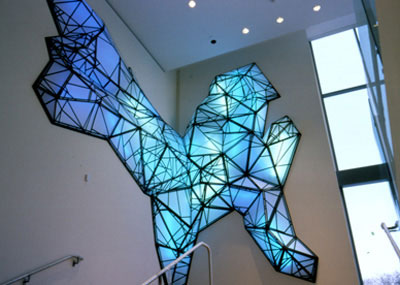
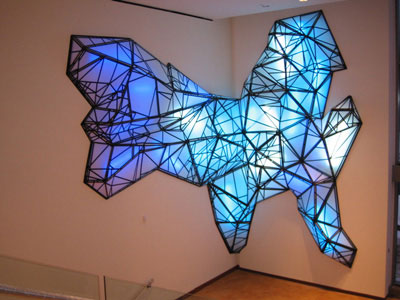
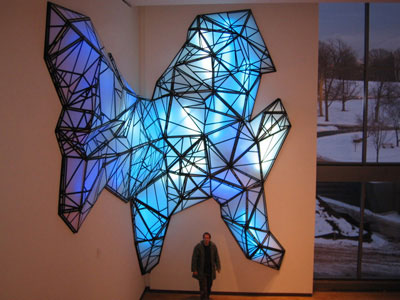
Stephen Hendee, The Eye, New Britain Museum, New Britain, CT, USA, 2005
points of comparison to the Nathaniel Stern work in the previous post:
-specifically evokes "wireframe" computer model (or "invokes" in the case of Stern, who uses the word in his title)
-reproduces wireframe outlines as an actual object
-"problematizes" computer drawing with surrealist invention, deformation
-use of materials such as tape and foamcor (Hendee) and rope (Stern) suggests folk-like or cargo-cult-like reification or fetishization of high technology
-inverts the idea of a computer as effortless and airy through the conspicuous employment of hand labor
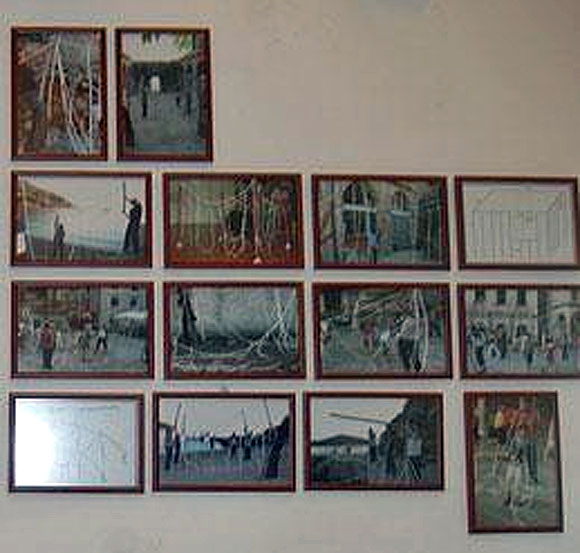
Apologies for the aggressive enlargement and resulting blurriness and artifacts in this photo by Joy Garnett. It's an installation of some photos of a performance work by Nathaniel Stern called The Wireframe Series: Sentimental Construction #1. Some clearer photos are here. This blog had its own wireframe aesthetics series a few years back so the topic is of interest. Paddy Johnson has little use for Stern's piece in her review of it today but it merits a stab at a long distance defense. The idea is to haul an Oldenburgized version of a 3-D computer drawing (what might be called "giant soft building outline") out into the streets of Dubrovnik and photograph people erecting it in the style of an Amish barn-raising. Thus hard becomes soft, virtual becomes actual, private becomes public. The sculpture is not of itself interesting--it is activated through its contact with people (like certain objects by Franz West or Helio Oiticica that were meant to be carried or worn) and by being photographed. In the photos, the softened or molten outlines of the rope building become a classic surrealistically "problematized" image, re-envisioning something hard and artificial as pliable and organic. They also represent a regression or devolution of the CAD-generated modernist box by being juxtaposed against the cobbled streets of an older Mediterranean city, and by their handling by real live human beings. Looks good from this side of the Atlantic and this side of the computer screen.
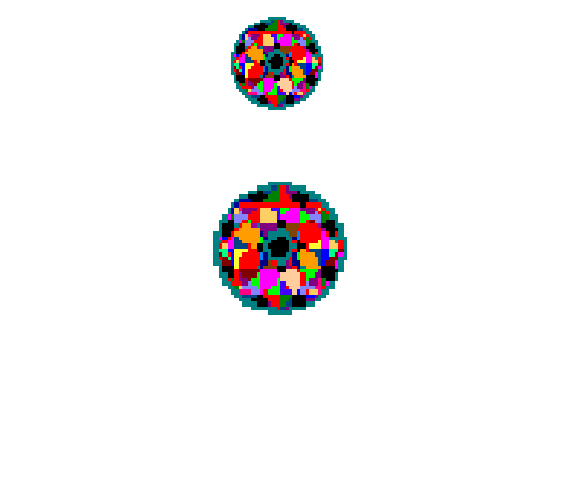
artist unknown--thanks to harm, who found it
The post on the Rhizome 2007-2008 commissions as XYZ Art (reblogged here, thanks cpb) elicited the following response:
Don't see how XYZ relates solely to these types of new media projects. Painting, sculpture, photography, many mediums use a trial-error process similar to science. For instance one commonly develops a style or signature process (the algorithm), often paying big gradschool dollars for it, then alters X strokes or colors, looks at the Z surface, changes X some, then goes for the super awesome Z for the finish. - ssrAnd my reply:
That's funny, but we're not talking about a trial-error process. It's more like one application: a single transformation of something into something that "helps others."
The art world equivalent would be a conceptual art work, something like Meg Cranston's Who's Who by Size, University of California Sample, 1994, where different fabric-covered sculptural stacks (Z) represent the number of inches of shelf space (X) that a subject (Edgar Allen Poe, Elvis Presley, etc) has in a college library. The algorithm or (Y) is assigning a fabric to the subject (Anna Pavlova in ballet slipper satin, etc) and making the stacks. The work has a point, and one point only, to show intuitively that "size matters" in assessing one's historical reputation. (I got this example and some of the description from the book Deep Storage, ed. by Ingrid Schaffner and Matthias Winzen.)
Grad schools turning out cookie cutter painting is rather a different issue.
etc:
spider car
cat vs TV reporter
super-pissed off cat
cat vs mini-helicopter
cobra vs baby (damn--"removed for terms of use violation"--oh, well)
from singe's journal
BruceB reconsiders the Niven & Pournelle science fiction novel The Mote in God's Eye in light of the "9/12 mentality" of Glenn Reynolds and other techno-class warmongers: "What most troubles me now is the glibness of it, the emphasis on the cleverness of the humans who see through the Motie deceptions, since this looms even larger than the courage of some humans who must die for the sake of plot developments. And itís completely callous about the wisdom and morality of just standing by and watching an entire society collapse into barbarism - since itís not the full-blown genocide some authorities had thought be necessary, itís an improvement, and it seems like since itís not genocide, itís A-OK. Other peopleís stuff is there to be exciting and interesting props, but it and its owners can be shoved around and broken up as need be, and what really matters (as presented in Mote) is the coolness of the humans whoíll do the pushing and breaking."
Science fiction/fabulist/slipstream/magic realist author A. A. Attanasio is beginning a new novel and letting readers look over his shoulder on his blog. He tucks the announcement into a longish post about a trip into the mountains of his native Hawaii, in the company of three elderly men who repair ancient shrines in the peaks, and the great-grandnephew of one of them, a young Marine who lost part of a leg in Fallujah:
The Marine shrugs. Clambering up the side of the colossal boulder and scouting from the top, he spies a cliff, which he believes we can climb to higher ground. I warn him that those trails are good for goats not people. He dismisses me and lumbers off into the fern maze. I would prefer to stay put and wait for the stonemovers to find us. But I can't let a friend's relative wander alone aimlessly, even though I have no idea where we are, and so the double leads me deeper into Adam's dream, a trance walk darkening toward nightmare.This open writing project will be a treat and it's entirely possible a new form of literature will start to emerge, just as art and music are changing with the advent of more porous boundaries among creator, consumer, and distributor. Few are better suited to the attempt than this writer with a strong posthuman thread in his fiction. His books to date (Radix, Centuries, Last Legends of Earth and others) are mind-expanding and there's no reason his blog can't be the same as he delves into this narrative.
Strenuously and repeatedly, I silently wish I had stayed home. This, of course, is the timeless desire to remain unborn and in the womb, the original (but not final) destination of the itinerant hero. Night descends before we find our way out of the grotto, and we crawl into our sleeping bags, pull up our mosquito cowls, and submit to the uterine regression of sleep and dreams.
On the way to dreamland, I work out some of the ideas for "Otherlight." The science inspiring the fiction is genetic amplification. Not long ago, I read about a genome wonder that entailed the inoculation of human DNA snippets (that code for color vision) directly into the eyeballs of color blind mice and monkeys and that immediately endowed these animals with color vision! The researchers were amazed at how quickly the recipient nervous systems went from b&w to color -- and that got me fantasizing about genetic transformations that could instantly add different senses, new ones, with a science fictional bent, like seeing other dimensions, parallel worlds ... and then not just seeing but interacting with and adventuring in alien universes. DNA in 10-space!
